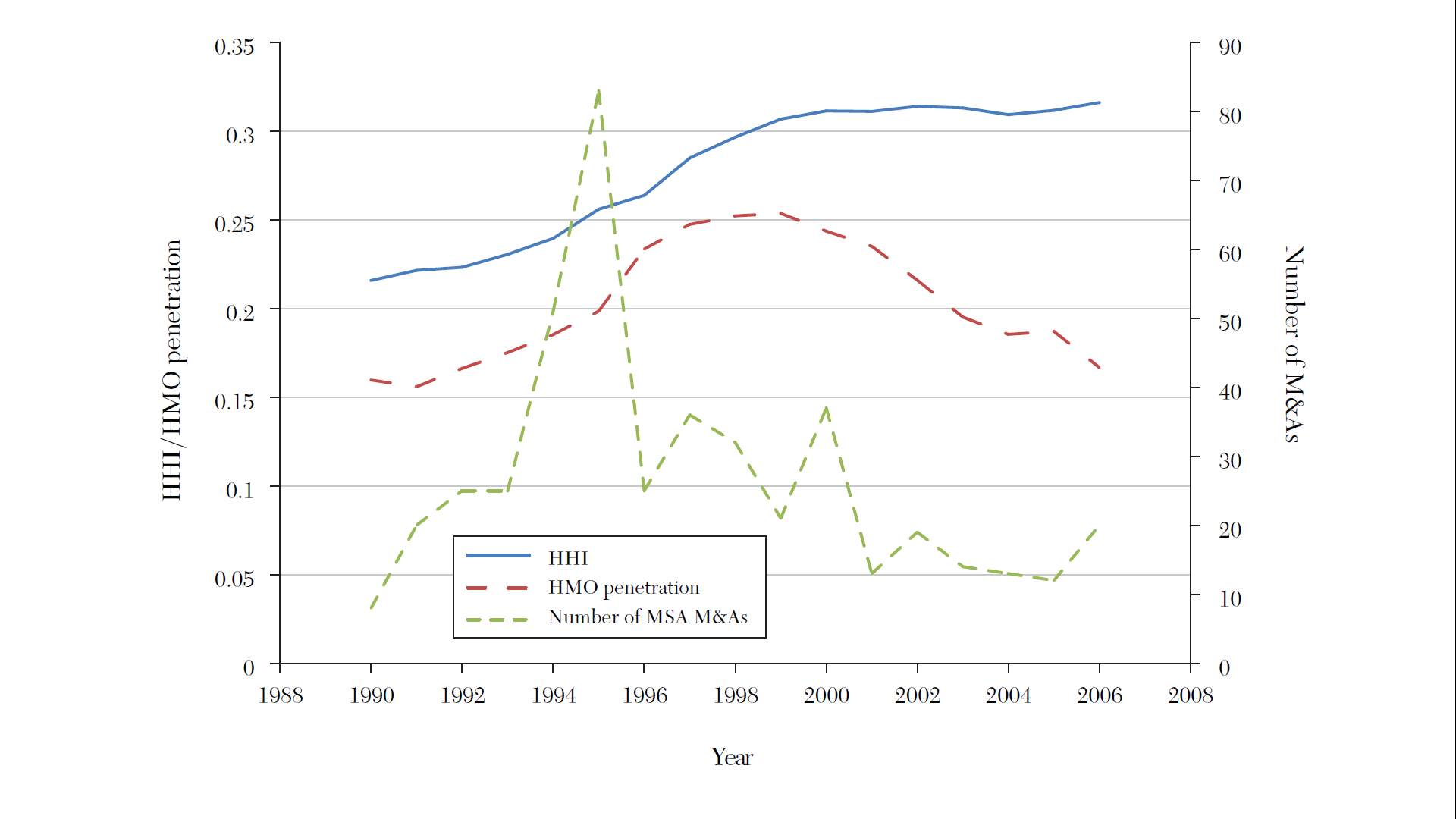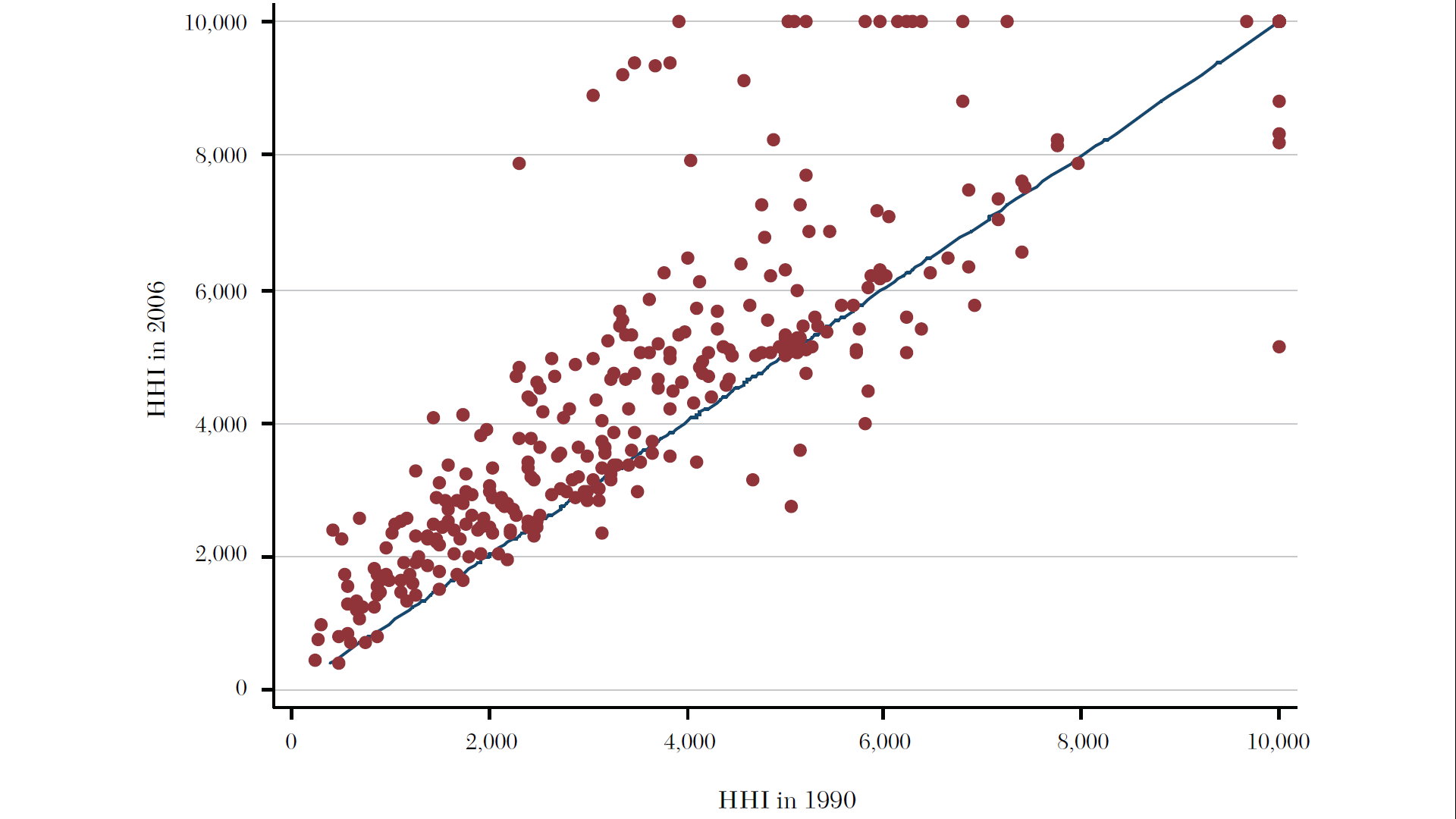class: center, middle, inverse, title-slide # Module 3: Hospital Pricing and Competition ## Part 3: Understanding Competition ### Ian McCarthy | Emory University ### Econ 372 --- <!-- Adjust some CSS code for font size and maintain R code font size --> <style type="text/css"> .remark-slide-content { font-size: 30px; padding: 1em 2em 1em 2em; } .remark-code, .remark-inline-code { font-size: 20px; } </style> <!-- Set R options for how code chunks are displayed and load packages --> # Central Empirical Issues At least 2 related issues in studying hospital competitiveness: 1. How do we measure "competitiveness"? 2. What is the effect of competition? --- # Measuring competitiveness - Common measure is Herfindahl-Hirschman Index (HHI), `\(\sum_{i=1}^{N} s_{i}^{2}\)`. - 2,500 is considered **highly concentrated** - 1,800 is considered **unconcentrated** - "Willingness to pay" is more recent measure (theoretically supported) - Both require a measure of the geographic market --- # Defining the market Lots of subjectivity... - Radius around a hospital? - Concentric circles to define "catchment" areas? - Patient/physician referrals? - At what product-level do hospitals compete? --- # Trends in competitiveness Almost any way you define it, hospital markets are more and more concentrated (less competitive) in recent decades. - 1990: 65% of MSAs highlgy concentrated, 23% unconcentrated - 2006: 77% highly concentrated, 11% unconcentrated --- # Hospital concentration over time .pull-left[  ] .pull-right[  ] <div class="smalltext">Source: <a href="https://www.aeaweb.org/articles?id=10.1257/jel.53.2.235">Gaynor, Ho, and Town (2015). The Industrial Organization of Health Care Markets. Journal of Economic Literature.</a></div> --- # Hospital concentration over time - More data and [interactive report](https://healthcostinstitute.org/hcci-originals/healthy-marketplace-index/hmi) from the Health Care Cost Institute. - [Presentation](https://nihcm.org/publications/hospital-consolidation-trends-impacts-outlook) from the National Institute for Health Care Management --- # Why? Historical perception of hospital competition as "wasteful" and assumption that more capacity means more (unnecessary) care: - Limit public spending by limiting competition - Prevalence of certificate of need (CON) laws --- # Effects of reduced competition 1. Higher prices 2. Lower quality, [2020 NEJM Paper](https://www.nejm.org/doi/full/10.1056/NEJMsa1901383) 3. Maybe lower costs (but not passed on to lower prices)<br> -- Effects for both "in-market" and "out-of-market" mergers --- # Modeling competition and prices Health care providers compete on both quality and price (possibly other dimensions such as access or wait times). This complicates our theoretical analysis of competition. --- # Competition with fixed prices - Demand: `\(q_{j}=s_{j}(z_{j}) \times D(\bar{p})\)` - Costs: `\(c_{j}=c(q_{j},z_{j}) + F\)` - Profits: `\(\pi_{j} = \bar{p}q_{j} - c_{j}\)` Hospitals choose quality such that: `$$\frac{d \pi_{j}}{d z_{j}} = \left(\bar{p} - \frac{d c_{j}}{d q_{j}} \right)\left(\frac{d s_{j}}{d z_{j}}D + s_{j}\frac{d D}{d z_{j}} \right) - \frac{d c_{j}}{d z_{j}}=0$$` --- # Competition with fixed prices - Increase in competition will tend to increase quality - Negative welfare effects if `\(\frac{d D}{d z_{j}}\)` is sufficiently small and fixed costs are large --- # Competition with market prices Profit given by `\(\pi = q(p,z) \times (p-c-d\times z) - F,\)` which yields `$$\begin{align*} p &= \frac{\epsilon_{p}}{\epsilon_{p}-1} (c+dz) \\ z &= \frac{\epsilon_{z}}{\epsilon_{z}+1} \frac{p-c}{d} \end{align*}$$` --- # Competition with market prices Rewrite in terms of elasticities: `$$\begin{align*} \epsilon_{p} &= \frac{p}{p-c-dz} \\ \epsilon_{z} &= \frac{dz}{p - c - dz} \end{align*}$$` Taking the ratio and solving for `\(z\)` yields, `$$z = \frac{p}{d}\times \frac{\epsilon_{z}}{\epsilon_{p}},$$` --- # Competition with market prices Dorfman-Steiner condition: - Quality increases if the quality elasticity increases or if price increases - Quality increases if the price elasticity decreases or the marginal cost of quality decreases - **Prediction for competition:** If competition has a large effect in terms of price elasticity (i.e., consumers are heavily responsive to the price effects from increased competition), then quality may decrease. If instead competition has a large effect in terms of quality elasticity (i.e., consumers are more responsive to quality changes), then quality will increase.